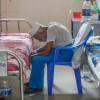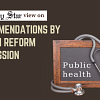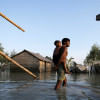Dengue situation shows why our health sector needs an overhaul

Over the last few years, dengue has evolved into a formidable adversary for Bangladesh's public healthcare sector, with the latter – already weakened by rampant corruption and gross mismanagement – doing a shoddy job of providing medical care to the increasing number of dengue patients. Last year, Bangladesh witnessed the highest dengue deaths, with 281 lives lost, since the first major outbreak in the country in 2000. But, as of Monday, the mosquito-borne disease has already claimed 416 lives this year, while the caseload stands at 87,891 – a significant jump from the already alarming 62,382 dengue cases recorded last year.
Dengue has become endemic to Bangladesh – ever-present, always lurking in the shadows. Moreover, the sharp spike in dengue cases this year should not come as a surprise since entomologists and health experts had been flagging this concern for some time now. But the authorities neither paid sufficient heed to these concerns, nor took timely measures to strengthen the healthcare system to bear the expected load of dengue cases. Starting from a shortage of regular beds, ICU facilities, resources and staff, to an imminent shortage of saline at present, the public healthcare system is close to succumbing under stress. Critical patients lying in hospital corridors, gasping for oxygen, for medical care, for medicine, and for an ICU bed is not an unfamiliar sight in any of the public hospitals in Dhaka. The scenario outside the capital is no better either.
According to the Directorate General of Health Services (DGHS), there are about 1,323 ICU beds and 886 HDU beds in various public hospitals across the country. But these numbers look paltry compared to the ever-increasing number of critical dengue patients. Take the case of Shaheed Suhrawardy Medical College Hospital, which has about 20 ICU and HDU beds. In the face of more and more patients seeking medical care at the facility, the hospital is now having to take signed undertakings from family members before admission. A similar situation also prevails at other hospitals, including Mugda Medical College and Hospital, Sir Salimullah Medical College Mitford Hospital, and Dhaka Medical College Hospital, among others.
Reportedly, public hospitals in at least 25 of the country's 64 districts do not have ICU facilities, leading to critically ill patients being turned away and sent to Dhaka for medical care. In the current context, critical dengue patients are being sent to Dhaka from various divisions to receive treatment, which is putting more pressure on the already crumbling capacity of the capital's hospitals.
This daily recently reported the case of 14-year-old Raifa, who had to be shifted to three different hospitals seeking critical care for dengue. Not a single vacant ICU bed could be found. Finally, her parents were forced to get her admitted to Shaheed Suhrawardy Medical College Hospital, knowing well that the hospital did not have the capacity to tend to Raifa's critical medical needs.
So, there is no doubt that the public healthcare system is in shambles. It is high time for the authorities to investigate and identify what has brought this sector to its knees. Of course, another question arises here: why have the authorities not been able to learn from the recent Covid-19 pandemic experience, and enhance the capacity of our healthcare system?
As a starting point of their soul-searching journey, the health authorities should look into why the health sector budget is not being fully utilised or properly implemented. Every budget season, experts and health professionals complain of the allocation for the health sector not being enough. But the problem does not lie with the allocation itself, rather with the utilisation of the allocated budget.
According to one report, from a 96 percent utilisation in FY2011, the figure plummeted to a disappointing 69 percent in FY2021. Also, over the last two years, the health sector's budget has witnessed utilisation rates below 80 percent. While the government has justified its high budget allocation for tertiary level healthcare with visions of setting up specialised hospitals in all divisional headquarters and new intensive care units and dialysis centres at district hospitals, the fact remains that, at the district and even divisional levels, existing healthcare facilities are often not even properly equipped to support primary medical care.
As such, while harbouring a grand vision for the health sector, the authorities should not lose sight of the current realities, namely the widespread corruption and resource mismanagement plaguing the sector. Corruption in the health sector has been well-documented by the media in various reports published over the last few years – unfortunately, to no visible effect. Meanwhile, the mismanagement of existing resources leading to human suffering has become a norm. This daily recently reported on how an X-ray room at the Madhabpur upazila health complex has remained locked and out of service for more than 16 years. The reason behind this? A new technician was not hired after the previous one was transferred in 2006. The machine itself was installed at the health complex in 2001. Of course, this has resulted in the suffering of locals from 11 unions of Madhabpur upazila, who are now being forced to seek X-ray facilities from private healthcare centres at a much higher price. In the report, the president of Madhabpur Press Club has alleged that the X-ray room has been kept under lock and key intentionally so that private X-ray businesses can reap more profits. If true, this would be a classic example of corruption in the form of a deliberate mismanagement of public resources.
Reportedly, public hospitals in at least 25 of the country's 64 districts do not have ICU facilities, leading to critically ill patients being turned away and sent to Dhaka for medical care. In the current context, critical dengue patients are being sent to Dhaka from various divisions to receive treatment, which is putting more pressure on the already crumbling capacity of the capital's hospitals.
Given the grim realities, it is safe to assume that our authorities have failed to leverage their experiences of past health crises to address the gaps in the health sector. Also, the under-utilisation of the yearly budget remains a major roadblock to the development of the sector, which is taking a toll in the form of a loss of human lives. All in all, Bangladesh's health sector needs to be cured of the corruption and mismanagement, which have been plaguing it for long. It needs major overhauling. The country's people must not die preventable deaths due to the incompetence and inefficiency of an ailing, corruption-ridden system.
Tasneem Tayeb is a columnist for The Daily Star. Her X handle is @tasneem_tayeb


 For all latest news, follow The Daily Star's Google News channel.
For all latest news, follow The Daily Star's Google News channel. 









Comments